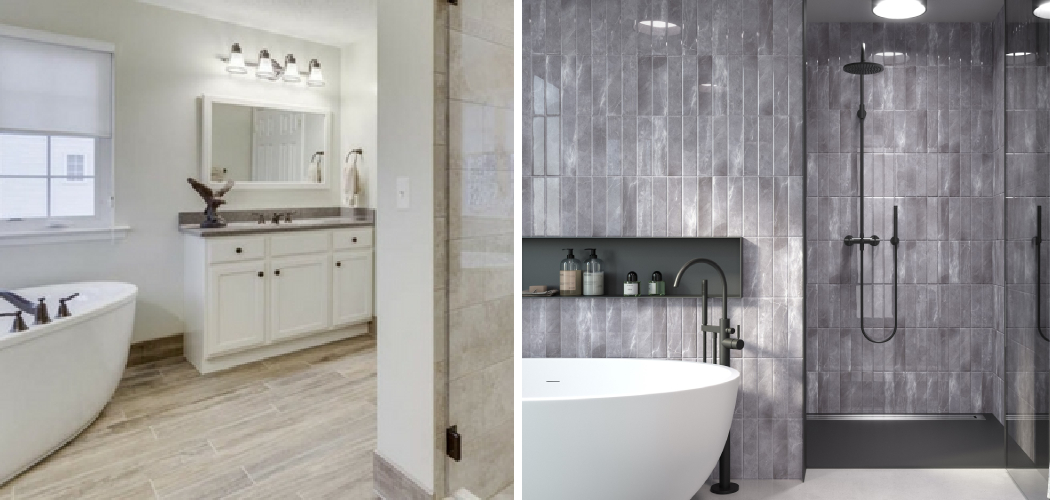Are you tired of looking at your old, outdated shower tile? Ready to give your bathroom a fresh, new look? Choosing the perfect shower tile can be overwhelming, with so many options available. But don’t worry; we’ve got you covered!
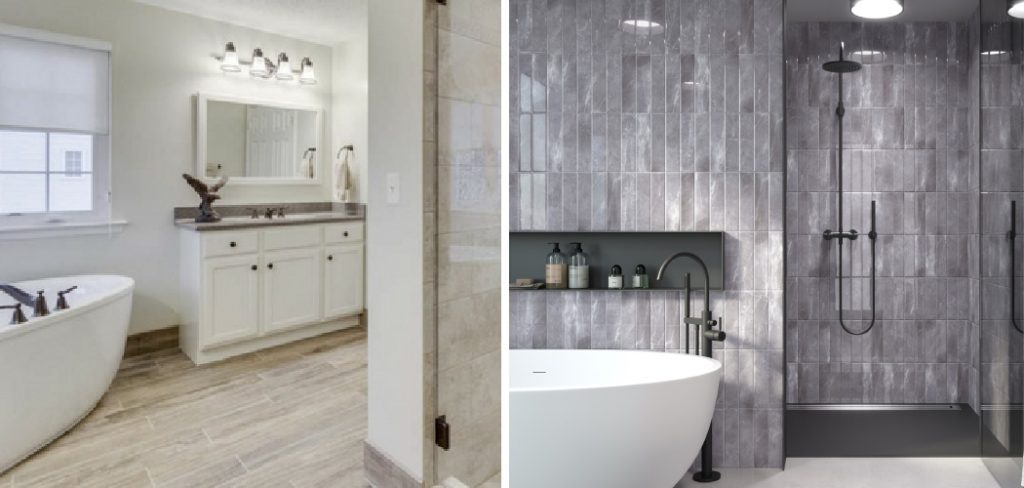
How to choose shower tile for your shower can transform a simple bathroom into a luxurious spa retreat. The options are exciting and overwhelming with an array of materials, colors, sizes, and textures available. The ideal shower tile is not only aesthetically pleasing but also durable and suitable for wet conditions.
This guide aims to simplify the selection process by considering factors such as water resistance, safety, maintenance, and overall design theme. Whether you’re renovating your bathroom or building a new one, the right tile can elevate the look of your space and ensure it meets your functional needs.
What are the Benefits of Choosing the Right Shower Tile?
Choosing the right shower tile can have a significant impact on your overall bathroom design and functionality. Here are some of the benefits of selecting the right shower tile:
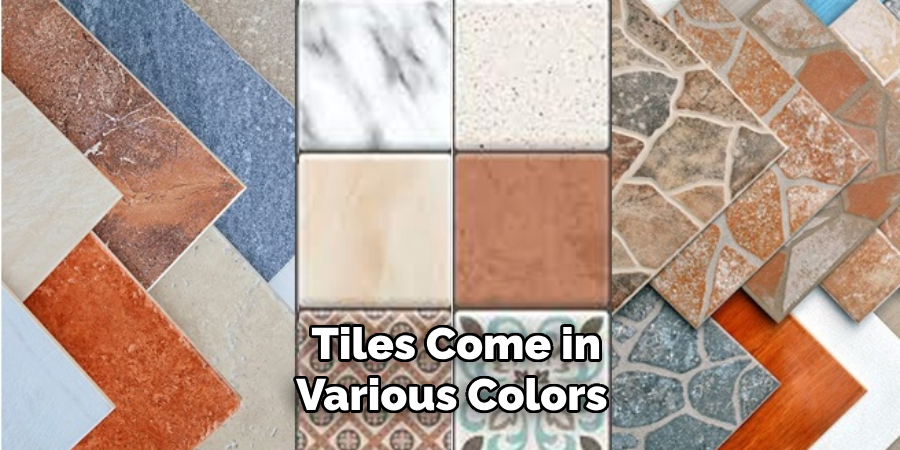
- Enhances The Visual Appeal: Shower tiles come in various colors, patterns, and textures, allowing you to customize the look of your bathroom. Whether you prefer a sleek and modern design or a more traditional and timeless look, there’s a shower tile that will suit your style.
- Increases Durability: The right shower tile can withstand daily wear and tear, water exposure, and cleaning products. This not only makes it a practical choice but also a cost-effective one in the long run.
- Improves Safety: Choosing slip-resistant tiles for your shower floor can help prevent accidents and injuries. This is especially important for households with children or elderly individuals.
- Easy to Maintain: Shower tiles are low maintenance and easy to clean, making them a practical choice for busy households.
- Customizable Layout: With various shapes, sizes, and patterns available, shower tiles allow you to create a unique layout that suits your personal style and bathroom space.
These benefits make it clear that choosing the right shower tile is crucial for both aesthetic and functional purposes. Now, let’s dive into some key factors to consider when selecting shower tiles.
What Will You Need?
Before you start shopping for shower tiles, it’s essential to have a clear idea of your needs and preferences. Here are some things you’ll need to consider:
- Design Theme: Determine the overall design theme of your bathroom. Are you going for a modern, traditional, or eclectic look? This will help narrow down your options and ensure that the shower tile fits in with the rest of your bathroom design.
- Budget: Determine how much you’re willing to spend on shower tiles. This will help you narrow down your options and avoid overspending.
- Tile Size and Shape: Consider the size and shape of your shower walls and floor when choosing tile sizes. Larger tiles can make a small space appear bigger, while smaller tiles can add more texture and visual interest.
- Water Resistance: Since your shower will be exposed to water daily, it’s crucial to choose water-resistant tiles. Porcelain and ceramic tiles are popular options due to their durability and low water absorption rates.
- Safety: As mentioned before, slip-resistant tiles are essential for a safe shower floor. Look for tiles with a textured or matte finish for added traction.

Once you have a clear understanding of your needs and preferences, it’s time to start exploring shower tile options!
10 Easy Steps on How to Choose Shower Tile
Step 1. Consider the Color Scheme:
Start by deciding on the color scheme you want for your bathroom. Remember, lighter colors can make a small space appear larger and more open, while darker colors can add drama and depth. Consider the overall ambiance you want to achieve.
Neutral colors offer timeless appeal, but don’t be afraid to incorporate accent tiles for a pop of color or an element of surprise.
Step 2. Select the Right Material:
Material selection is crucial when choosing shower tiles, as it affects your bathroom’s appearance and functionality. Porcelain and ceramic tiles are popular for their durability and water resistance, making them ideal for showers. However, if you’re looking for something with a bit more texture or a natural look, stone tiles such as marble, slate, or travertine might be the right choice.
Keep in mind that stone requires more maintenance, including regular sealing, to prevent water damage. Consider glass or mosaic tiles for a more affordable option that still offers a wide range of designs. When selecting the material, consider your lifestyle, budget, and the level of maintenance you’re willing to commit to.
Step 3. Think About Texture and Finish:
The texture and finish of your shower tiles will not only influence the overall look of your bathroom but also its safety and maintenance requirements. For the shower floor, opt for tiles with a matte or textured finish to ensure slip resistance. Glossy tiles can be used on the walls to reflect light and create a more spacious feel.
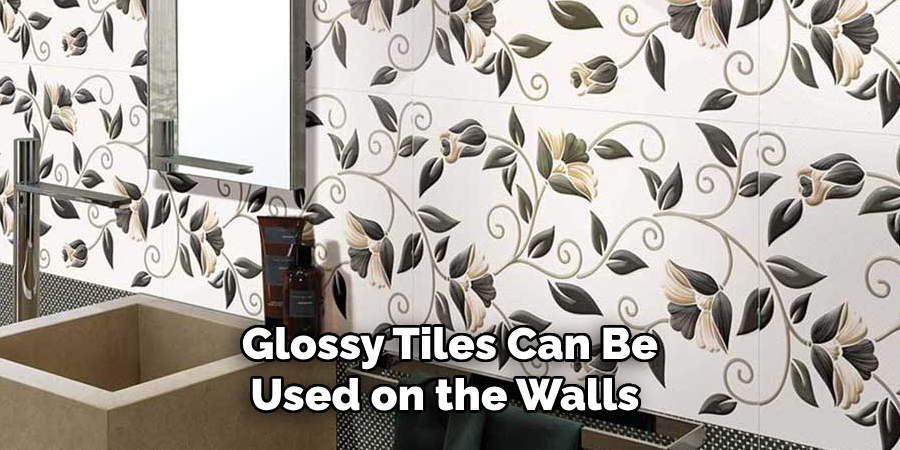
Additionally, textured tiles can hide water spots and fingerprints, making them more forgiving regarding maintenance. Consider the balance between aesthetics and functionality to choose the best texture and finish for your shower area.
Step 4. Size Matters:
When selecting shower tiles, size plays a critical role in your bathroom’s overall look and feel. Large tiles can create a seamless, open look with fewer grout lines, making the shower easier to clean.
On the other hand, smaller tiles, such as mosaic tiles, offer more slip resistance due to the increased number of grout lines, providing better grip underfoot.
Consider the size of your shower area when choosing tile size; larger tiles work well in spacious showers, while smaller tiles can be ideal for tighter spaces or decorative accents. Remember, the right size tile can significantly impact your bathroom’s design aesthetic and functional efficiency.
Step 5. Pattern and Layout:
The pattern and layout you choose for your shower tiles can dramatically affect the space’s visual appeal. Herringbone, basketweave, and chevron are popular patterns that add interest and dimension to your shower walls or floor.
Consider using a feature wall with a bold pattern or color to serve as a focal point for a more unique look. Remember, the way tiles are laid out can influence the perception of space within your bathroom.
Vertical tile layouts can make walls appear taller, while horizontal layouts can make the space seem wider. Carefully consider the overall effect you wish to achieve when planning your tile pattern and layout, ensuring it complements the size and shape of your shower area.
Step 6. Consider the Grout:
Choosing the right grout is just as important as selecting the tile itself since it can dramatically affect the appearance and longevity of your shower. The color of the grout can either complement or contrast with your tiles, influencing the overall design of your bathroom.
Lighter grout colors can create a subtle, cohesive look, while darker grout can define tiles more distinctly and hide stains better. It’s also vital to choose mold and mildew-resistant grout to ensure a clean and healthy shower environment.
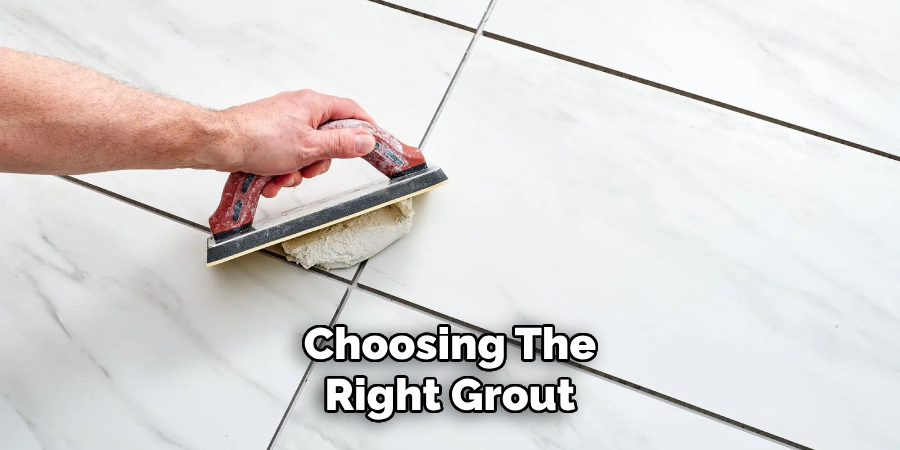
Consider using epoxy grout for its durability and water-resistant properties, although it may require a professional for application. Take the time to select the right grout color and type to enhance your shower’s beauty and functionality.
Step 7. Lighting Considerations:
The lighting in your bathroom can significantly influence how your shower tiles look and feel.
Natural light can make colors appear different than artificial light, so it’s important to consider the type of lighting when choosing your tiles. You might opt for darker tiles for bathrooms with ample natural light to add warmth and depth.
In contrast, for bathrooms with limited natural light, lighter tiles can help brighten the space and make it seem larger. Additionally, consider the placement of light fixtures to ensure they enhance the tile’s color and texture without creating unwanted shadows or glare. Choosing the right tile in conjunction with thoughtful lighting design can transform your shower into a bright and inviting space.
Step 8. Maintenance and Cleaning:
The ease of maintenance and cleaning should also be a key consideration when selecting shower tiles. Porcelain and ceramic tiles are generally low maintenance, requiring just routine cleaning to keep them looking new.
Natural stone tiles, while beautiful, require more care, including specific cleaning products and regular sealing to protect against staining and water damage. Glass and mosaic tiles can show water spots more readily, so they may need more frequent cleaning to maintain their shine.
When choosing your shower tiles, think about your daily routine and how much time you will dedicate to cleaning. Opting for tiles that suit your lifestyle will ensure your bathroom remains a sanctuary, not a chore.
Step 9. Final Considerations and Warranty:
Before making your final selection of shower tiles, it’s crucial to consider the warranty and after-sales support offered by the manufacturer or retailer. A good warranty can provide peace of mind, covering potential defects or issues with the tiles.

This step is often overlooked but is essential in ensuring the longevity and durability of your investment. Additionally, consider the environmental impact of your tile choice. Eco-friendly options such as recycled glass or sustainably sourced materials can contribute to a greener home without compromising on style or quality.
By carefully considering all aspects of your shower tile decision, from aesthetics to ethics, you can create a space that aligns with your values and meets your design expectations.
Step 10. Installation Process:
The installation process of your shower tiles is crucial for ensuring your bathroom space’s longevity and aesthetic appeal. It’s important to decide whether you will undertake this project as a DIY endeavor or hire a professional tile installer.
While DIY can be cost-effective for those with the necessary skills, professional installation ensures that the job is completed with precision and expertise, potentially saving you time and avoiding costly mistakes.
Ensure that the installer you choose has experience with the specific type of tiles you’ve selected, as different materials might require unique installation techniques. Additionally, discuss the timeline and any preparation work that needs to be done prior to installation, such as waterproofing the shower area.
Proper installation not only enhances the visual appeal of your bathroom but also prevents future issues, such as water damage or tile displacement.
By following these 10 steps, you can confidently select and install shower tiles that not only elevate the look of your bathroom but also provide a functional and durable solution for years to come.
5 Additional Tips and Tricks
1. Consider the Slip Resistance: Safety should be a top priority in your selection process. Opt for shower tiles that offer good slip resistance to avoid accidents. Look for tiles with a high coefficient of friction.

2. Think about Maintenance: Some tiles require more maintenance than others. If you prefer a low-maintenance bathroom, consider porcelain or ceramic tiles since they’re easier to clean and resist water better than natural stone.
3. Choose the Right Size: The size of the tile can significantly impact the appearance of your bathroom. Larger tiles can make a small bathroom feel bigger but might not fit well around corners or in smaller showers. Mix and match tile sizes for a balanced look.
4. Blend Function with Style: While functionality is crucial, you want your shower to reflect your style. With the vast selection of colors, patterns, and finishes available, you can choose tiles that not only serve their purpose but also enhance your bathroom’s aesthetic.
5. Consider Longevity and Trends: While choosing the latest tile trend is tempting, remember that bathrooms are not renovated frequently. Selecting a timeless design will ensure your bathroom remains stylish and functional for years to come.
With these additional tips and tricks, you can confidently choose the perfect shower tiles for your bathroom.
5 Things You Should Avoid When Choosing Shower Tile
1. Ignoring Waterproof Qualities: Not all tiles are suitable for wet areas. Avoid tiles that absorb moisture easily, such as certain types of natural stone, unless they are properly sealed. Always opt for waterproof tiles in showers to prevent water damage and mold growth.

2. Choosing Style Over Safety: While aesthetics are important, safety should never be compromised. Avoid tiles with glossy finishes that can become slippery when wet. Instead, select tiles that combine style with slip-resistant properties.
3. Overlooking Tile Porosity: Tile porosity is a critical factor in shower areas. High porosity tiles absorb more water, which can lead to damage over time. Make sure to avoid tiles with high porosity levels for shower floors and walls.
4. Neglecting Grout Selection: The choice of grout is as important as the tile itself. Avoid using a grout that doesn’t complement the tile’s water resistance and durability. Ensure your grout choice is suitable for wet environments, and consider color sealants to maintain its appearance.
5. Forgetting About Installation Requirements: Different tiles have different installation requirements. Avoid purchasing tiles without considering the installation process. Some tiles may require a certain type of adhesive or grout. Incorrect installation can lead to problems down the line, so ensure compatibility and consider professional installation for best results.
By avoiding these common mistakes, you can ensure a successful and functional shower tile selection for your bathroom. Remember to prioritize safety, durability, and maintenance when making your decision.
5 Different Types of Shower Tile Materials
1. Ceramic: This is the most popular and affordable option for shower tiles. It’s water-resistant, easy to clean, and comes in a wide range of colors and patterns.
2. Porcelain: Similar to ceramic, porcelain tiles are also durable and low-maintenance. They have a lower water absorption rate, making them less prone to damage from water.
3. Natural Stone: This includes marble, granite, and slate materials. While they offer a luxurious look, natural stone tiles require more maintenance and are generally more expensive.
4. Glass: For a modern and unique look, glass tiles can be a great option for shower walls. They’re easy to clean and can add dimension to your bathroom.
However, they may require more frequent cleaning as they can show water spots.
5. Mosaic: Made up of smaller tiles, mosaic tiles come in various materials and can be used to create intricate designs. They’re great for adding texture and visual interest to the shower area.
With these different types of shower tile materials, you can choose the one that best fits your budget, style, and maintenance preferences.
Conclusion
How to choose shower tile involves a delicate balance between functionality, safety, style, and maintenance. By considering factors such as slip resistance, water resistance, longevity, and aesthetic appeal, homeowners can make informed decisions that enhance the beauty and practicality of their bathrooms.
Furthermore, understanding the characteristics of different materials—from the versatile and affordable ceramic and porcelain to the luxurious but high-maintenance natural stone—allows for a tailored approach to bathroom design.
Remember to also weigh the implications of tile size, porosity, and installation requirements to ensure a successful outcome. Armed with the insights provided, you’re now equipped to select shower tiles that not only meet your practical needs but also reflect your personal style, ensuring a bathroom that you’ll enjoy for many years to come.

